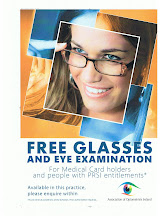Sun Safety for your eyes
A recent survey showed that while the majority of the public were aware of the damage UV light can do to the skin, the majority of individuals surveyed, did not know that UV light can seriously damage the eyes. So, the Association of Optometrists is urging the general public to take care and be sun aware.
Exposure to UV light, found in sunlight can cause damage to or lead to cancer of the eye lids and skin around the eyes. It can speed up and increase the risk of sight threatening conditions such as cataracts and age related macular degeneration (AMD). It can also cause problems such as pterygium and pinguecula, which are growths which form on the conjunctiva of the eye and can lead to problems with the eyes in the future. Even just one day exposure to the sun can lead to sunburn of the cornea, which is painful and can cause temporary vision loss.
Just as sunlight ages the skin, it ages the eye. Research indicates that wearing the correct sunglasses can reduce aging in the eye by 20 years and reduces the risk of early cataract formation by up to 40%.
In choosing the right sunglasses, the advice is;
· Use lenses which block out 99% of UVA and UVB light
· Mirrored, polarizing and photochromatic lenses may not provide enough UV protection, additional UV filters may be required
· Fashion and designer sunglasses may not provide adequate protection or give good clarity of vision
· Lenses should provide clear distortion free vision and should not affect colour perception
· If participating in outdoor sports, choose sunglasses which suit the visual requirements of the sport and are impact resistant
· Frames should be wide and deep enough to cover the whole eye area. They should have wrap around or thick sides to prevent light leaking in.
· Most prescriptions can be made up in proper sunglass frames with lenses which are fully UV protective, polarizing and anti-glare.
· If you wear contact lenses talk to your optometrist about lenses which have built in UV filters in the lens material.
· Wear a wide brimmed hat as well as your sunglasses in very sunny conditions to maximise protection.
Children are most at risk. They are outside more and their delicate eyes are more permeable to UV radiation. 80% of sun damage to the eyes is done by the age of 18! Parents should encourage children to wear good sunglasses and a wide brimmed hat.
Some medications can increase your sensitivity to light. These drugs can make your eyes more prone to sun damage. If you are taking such drugs, remember to take extra care with your eyes and be extra vigilant about protecting them from light, even in dull conditions, when outdoors.
Reprinted from the Website of the Association of Optometrists
Music
-
*It's been a while since I posted here but here's a link to some very
beautiful music : http://www.soundsblue.com/*
14 years ago











